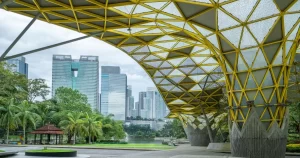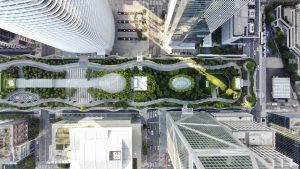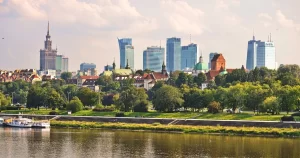5 Best Green Cities in Europe to Visit for Attractivity & Green Living
By Mz Chaker & EAGC │June 15, 2025
Discover the 5 Best Cities in Europe to Visit for green travel, stunning sights, and eco-friendly experiences you’ll never forget.

Imagine waking up to the scent of clean air, stepping outside into bike-friendly streets, and watching the city skyline blend seamlessly with lush greenery. Across Europe, a quiet revolution is reshaping cities into vibrant havens of Sustainability and beauty. As urban challenges like climate change and overpopulation grow, some cities are rising above with inspiring green solutions. But among all, which ones truly stand out for combining innovation, environmental care, and unforgettable charm?
This article explores the Best Green Cities in Europe to Visit—places where urban living meets environmental care—as ranked under the Planet pillar of the Arcadis Sustainable Cities Index 2024, which focuses on ecological sustainability. We will explore which Cities lead by example and what makes them irresistible travel destinations. From cycling paradises to cutting-edge Green Buildings, we’ll answer the question: How do these cities integrate eco-design into daily life?
1. Oslo: Norway’s Eco-Wonderland of Green Design and Culture
Let’s start with a city that blends dramatic landscapes, progressive urban policies, and a deep love for the environment. Below, we explore how Oslo has turned Sustainability into a way of life, setting a high bar for other green cities across Europe.

How Oslo Became One of the Best Green Cities in Europe to Visit
Norway’s capital, Oslo, is a beacon of sustainability, innovation, and scenic beauty. It earned the title of European Green Capital in 2019—and with good reason (European Commission).
Over the last decade, Oslo has embraced eco-conscious planning with remarkable results. From car-free city zones to clean-energy ferries, Oslo integrates Sustainability into the rhythm of daily life. Citizens enjoy cleaner air, easier commutes, and a deeper connection to nature.
One significant turning point was the city’s bold climate strategy, aiming for a 95% reduction in greenhouse gas emissions by 2030 (as outlined in Oslo’s official Climate Strategy towards 2030). Oslo also heavily invests in public transport, electric mobility, and Green Architecture. Its transformation reflects a broader cultural shift where design, environment, and well-being walk hand in hand. That’s what places Oslo among the Best Green Cities in Europe to Visit.
Sustainability at Its Core: Public Transport, Green Roofs & Urban Forests
Oslo’s green identity is rooted in a strong public transportation network, which includes electric trams, buses, and ferries. Indeed, 85% of all public buses run on renewable energy, according to Eurocities. The city has also introduced car-free zones and Green Roofs in new developments to absorb rainwater and reduce heat islands.
Urban forests and vast parks are part of daily life. With more than 1,700 parks, Oslo ensures that Green Spaces are within walking distance of every resident. These natural features double as carbon sinks, improving air quality and biodiversity.
It’s not just the infrastructure—it’s the mindset. Citizens support bold sustainability measures because the city makes it easier to choose greener habits every day.
Must-See Eco-Spots: The Iconic Oslo Opera House & Barcode District
One cannot visit Oslo without marveling at the Oslo Opera House, an icon of modern Green Design. Designed to rise from the fjord like an iceberg, its white roof invites visitors to walk and enjoy panoramic views, making the building both a cultural and environmental statement.
Nearby, the Barcode District showcases cutting-edge Sustainable Architecture. Its mix of residential, commercial, and cultural buildings meets green certification standards, combining aesthetic charm with Energy Efficiency.
These landmarks reflect Oslo’s effort to balance urban growth with environmental care. Eco-tourists will find themselves immersed in both nature and innovation.
Oslo’s Green Building Boom: Eco-Architecture That Blends with Nature
Green Buildings are reshaping Oslo’s skyline. Developments like the Valle Wood office building use cross-laminated timber and feature energy-efficient systems that slash emissions while offering serene, wood-infused interiors. Even older structures undergo ecological renovations, meeting high BREEAM and LEED standards.
Architects in Oslo adopt a biophilic design approach, integrating natural light, plants, and ventilation to promote occupant well-being. Whether it’s a museum, a school, or a housing project, the ethos is evident: buildings must give back to the environment.
Thanks to policies that reward sustainable construction, Oslo remains at the forefront of Europe’s movement for Green Building.

Oslo Green Areas- [d] Car Free City by @ Steve Boland on flickr.com

Oslo Green Buildings : [d] Thon Hotel Opera by @ Robert Scarth on Flickr.com
1.5. Where to Stay: Eco-Friendly Hotels and Green Living Spaces
Visitors to Oslo can choose from a growing list of eco-certified hotels, like the Thon Hotel Opera or Scandic Vulkan. These hotels reduce water usage, serve organic food, and promote energy conservation.
For more extended stays, green co-living spaces and Airbnb listings often include solar panels, heat recovery ventilation, and green roofs. Moreover, Oslo’s hospitality industry is as dedicated to sustainability as its public sector.
Whether you are staying in the city center or near the Oslo fjord, you’ll experience Sustainability firsthand. Every detail—from filtered tap water to bicycle rentals—supports your journey toward conscious travel.
2. Copenhagen: Europe’s Green Dream Where Biking Meets Bold Design
After Oslo’s remarkable eco-journey, we now head to another Scandinavian gem leading the charge in sustainable urban life. Copenhagen’s success story is one of seamless integration—where environmental goals, architectural design, and a vibrant lifestyle all work in harmony.

Green Living in Action: How Copenhagen Leads by Example
Copenhagen has long been a trailblazer in Urban Sustainability. The Danish capital consistently ranks at the top of Green City indexes thanks to its integrated approach to Sustainability and Urban Planning. The city aims to achieve carbon neutrality by 2025—a goal it actively pursues through Smart Solutions, Renewable Energy, and widespread citizen involvement.
Every element of the city functions as part of a green ecosystem. Wind power generates much of the city’s electricity, and sustainable heating systems keep homes warm during the cold Nordic winters. In Copenhagen, Green Living is not a trend—it’s a way of life.
This commitment is visible in every corner, from the city’s trash-sorting culture to energy-positive buildings. That’s why Copenhagen stands proudly among the Best Green Cities in Europe to Visit.
Biking Heaven: A City Designed for Pedal Power
Copenhagen is a cyclist’s paradise. With over 375 kilometers of dedicated bike lanes (wonderful copenhagen), 49% of residents commute by bike every day (bicycle colorado). Even during winter, the city maintains clear and safe routes to encourage year-round cycling.
This dedication pays off—reducing traffic, improving air quality, and promoting healthy lifestyles. Bike bridges such as the Cycle Snake make the canals a smooth ride, turning daily commutes into scenic experiences.
For visitors, renting a bike is the best way to explore the city. And with integrated bike-share systems and city maps tailored for two wheels, getting around Copenhagen could not be easier—or greener.
Sustainable Architecture Showcase: CopenHill, Ørestad & Nordhavn
Copenhagen turns Sustainable Architecture into a cultural experience. One striking example is CopenHill, a waste-to-energy plant that sits atop an urban ski slope and hiking trail. It showcases how Green Design can blend recreation, energy production, and bold architecture.
In the districts of Ørestad and Nordhavn, entire neighborhoods meet eco-design principles. From passive housing to solar panels and smart waste systems, these areas are living laboratories for green innovation. Copenhagen doesn’t just build sustainably—it builds for the future.
Green Food, Green Fashion, Green Vibes: A Sustainable Lifestyle Hub
Copenhagen’s eco-mindset extends far beyond buildings. It’s home to a thriving green lifestyle scene. Organic restaurants, zero-waste shops, and sustainable fashion brands define the city’s identity. The Noma effect, born from the world-renowned restaurant, has inspired a culinary movement focused on local, organic ingredients.
Markets like Torvehallerne offer farm-to-table experiences, while upcycled boutiques and green tech expos keep visitors inspired and engaged. Whether you’re a foodie, a fashion lover, or a sustainability advocate, Copenhagen offers a vibrant, eco-conscious culture.

[b] Ørestad distrcict : photo by @ News Oresund, CC BY 2.0, via Wikimedia Commons
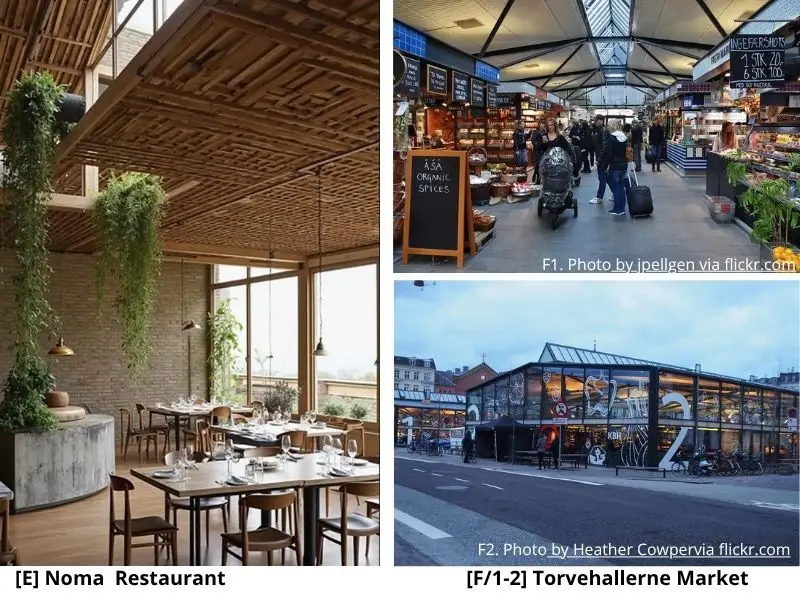
[F] Torvehallerne Market – photos : [F1] by @jpellgen vi flickr.com; [F1] by @by Heather Cowpervia flickr.com
Why Copenhagen Deserves Its Spot as a Top Green City in Europe
Copenhagen earns its green title not just through projects but through a shared vision. Government policies, business innovation, and public behavior are aligned toward a common goal: achieving climate resilience and enhancing quality of life.
It’s a place where environmental care enhances urban joy. Streets feel alive, the air feels fresh, and progress feels possible. Copenhagen proves that big ideas can thrive on a human scale—making it one of the Best Green Cities in Europe to Visit.
3. Berlin: Germany’s Urban Jungle of Innovation and Green Infrastructure
As we move into Central Europe, Berlin stands out as a city where history, innovation, and nature intertwine. The sections below highlight how Berlin is reimagining its urban landscape with sustainability at its core.

From Concrete to Canopy: Berlin’s Journey to Becoming a Green City
Berlin, once a divided city marked by concrete and walls, is now a thriving example of urban regeneration and ecological planning. Its transformation into a modern Green City didn’t happen overnight. Strategic investments in Renewable Energy, Green Mobility, and urban rewilding have helped Berlin evolve into one of the Best Green Cities in Europe to Visit.
After the fall of the Berlin Wall, vacant lots and industrial spaces transformed into urban gardens, public parks, and solar farms. Today, Berlin is home to over 2,500 green spaces, and nearly 44% of the capital is composed of forests, parks, rivers, and lakes (CitiNature, Wikipedia). This Eco-transformation exemplifies how a city can rewrite its history through Sustainability.
Eco-Neighborhoods & Urban Farming: A Local Movement Takes Root
Berlin embraces a bottom-up approach to sustainability. Communities have turned rooftops into gardens and parking lots into urban farms. Initiatives like Prinzessinnengarten in Kreuzberg empower citizens to grow local produce and share green knowledge. These efforts foster food security and environmental awareness.
The city also supports eco-districts such as Schöneberg and Adlershof. These neighborhoods are designed with Renewable Energy Grids, passive house buildings, and shared green courtyards. Sustainability is baked into everyday life, not just a top-down mandate. This grassroots momentum sets Berlin apart as a Green City that empowers its residents.
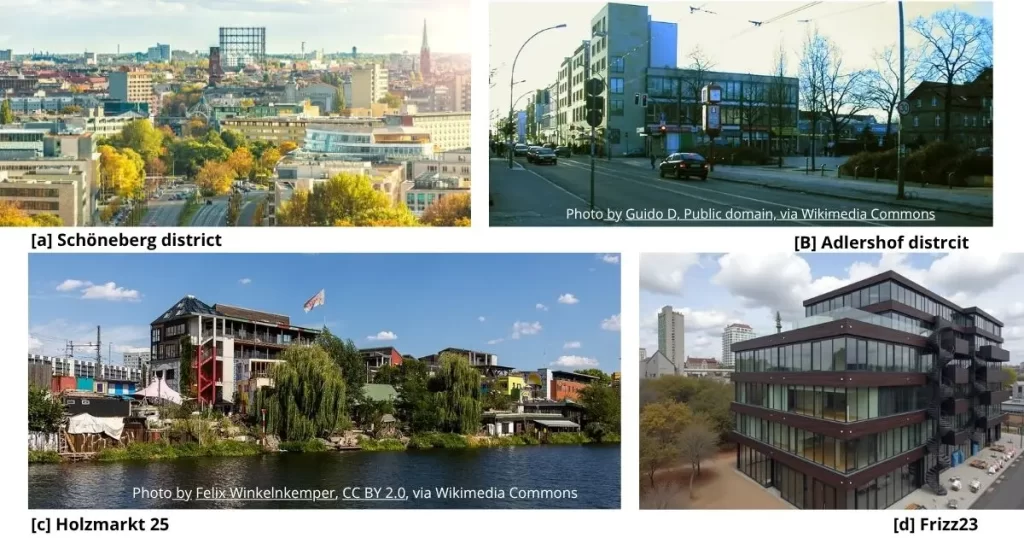
[b] Photo by Felix Winkelnkemper, CC BY 2.0, via Wikimedia Commons
Berlin’s Green Buildings: Solar Design & Passive Housing
Berlin champions progressive building standards. Many new developments meet or exceed Passive House criteria, ensuring ultra-low energy use and superior indoor air quality. Examples include the Holzmarkt 25 complex and Frizz23, which showcase innovative materials and solar integration.
Berlin is also home to the Environmental Forum at the Berlin Cathedral, one of the most energy-efficient conference centers in Europe. The city’s building codes promote Green Buildings that are adaptable, efficient, and inclusive. Whether it’s a co-living space or a high-tech office, sustainable architecture is part of the blueprint.

[a1] Photos by @ Jean-Pierre Dalbéra, via flickr.com ; [a2] :Photos by @ Jean-Pierre Dalbéra, via flickr.com; [d] Photo@by Robert Aehnelt, CC BY-SA 3.0, via Wikimedia Commons
Parks, Forests & Waterways: Nature Weaved into Urban Living
What makes Berlin indeed unique is how nature pulses through its urban core. Tiergarten Park, Berlin’s green lung, stretches over 520 acres. The Tempelhofer Feld, a former airport now a public park, offers space for cycling, gardening, and community events. Lakes like Wannsee and rivers like the Spree provide clean, swimmable water bodies.
Berlin’s landscape design prioritizes biodiversity. Wildlife corridors, bird habitats, and native plantings enrich the urban ecosystem. The city has even developed a Biotope Area Factor to ensure new developments support local flora and fauna. For residents and visitors alike, Berlin offers a seamless blend of urban life and nature.
Top Attractions for the Conscious Traveler
Berlin caters to eco-conscious tourism. The city boasts dozens of eco-hotels that use green energy and waste-reduction systems. Museums like Futurium explore sustainable futures, while green tours offer insights into Berlin’s climate innovations.
Travelers can bike through dedicated lanes or hop on a 100% renewable-powered train. Local vegan eateries, second-hand fashion hubs, and low-waste markets make sustainable living accessible. Berlin doesn’t just invite you to visit—it inspires you to live differently. It is no wonder it’s a top contender among the Best Green Cities in Europe to Visit.
4. London: A Megacity on a Mission for Sustainability
As we journey into the heart of the UK, let’s explore how London is reimagining urban life through sustainability. The following sections reveal how this bustling city balances innovation, greenery, and bold climate goals in its quest for a livable and low-carbon future.
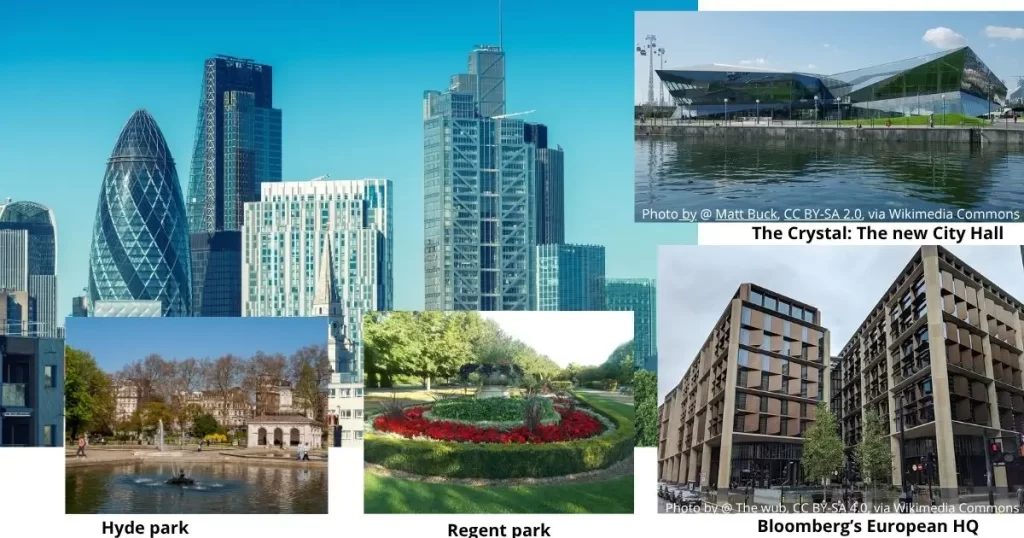
How London Combines Big-City Buzz with Green Ambitions
London is not the first city that comes to mind when you think of sustainability. Yet this global metropolis is proving that even a sprawling megacity can pivot toward a greener future. With its ambitious net-zero targets and expanding green initiatives, London is emerging as a strong player among the Best Green Cities in Europe to Visit.
From congestion charges that limit car traffic to smart infrastructure that monitors energy and emissions, London is aligning its urban policies with sustainable living. The result? A thriving city that marries its rich history with a cleaner, greener present.
The Rise of Green Building in London: From the Shard to Eco-Social Housing
London’s skyline is evolving to reflect its mission of Sustainability. Buildings like The Crystal and Bloomberg’s European HQ are global leaders in Energy Efficiency. The city’s updated building codes encourage developers to pursue BREEAM certification and integrate renewable technologies such as solar panels, green roofs, and smart water systems.
Beyond its iconic skyscrapers, London also invests in social housing projects that emphasize energy performance and low-carbon materials. These developments prove that Green Buildings can be inclusive and affordable. Sustainability in London is not a luxury—it’s a necessity for everyone.
London’s Green Spaces: Hyde Park, Regent’s Park & New Urban Forests
Despite its density, London remains one of the greenest capitals in the world. Nearly 47% of the city is green space (GiGL, 2023), earning it the title of a National Park City. The parks of Hyde and Regent offer iconic examples of how nature thrives within a modern city. But it does not stop there.
Initiatives like the London Urban Forest plan aim to plant millions of trees by 2050. The city is also rewilding urban zones, creating wildflower corridors and wetlands to support pollinators and biodiversity. These efforts not only enhance public health but also strengthen the city’s climate resilience.
Smart City, Green Heart: Urban Planning for a Low-Carbon Future
London is rapidly digitizing its infrastructure to reduce carbon emissions and improve city life. Smart meters, climate dashboards, and low-emission zones are just a few tools transforming the capital. The city’s transport system now includes hybrid buses, an expanded cycle highway network, and the all-electric Elizabeth Line.
Urban planning focuses on mixed-use developments, reduced commuting distances, and pedestrian-first design. Combined, these strategies align with the city’s 2030 net-zero target and underscore its role as a leading Green City in Europe.
Why London is a Must-Visit Among the Best Cities in Europe to Visit
London is more than a historic capital—it’s a living laboratory for green innovation. Visitors can explore eco-markets, dine at zero-waste restaurants, and stay in EarthCheck-certified hotels. Cultural institutions, from the Natural History Museum to the Tate Modern, now feature sustainability exhibitions and eco-conscious programs.
Whether you are a traveler, architect, or climate enthusiast, London offers a unique glimpse into how sustainability can scale in complex urban settings. As the city continues to lead with bold policies and grassroots activism, it secures its place as a must-visit on the European green city map.
5. Rotterdam: The Netherlands’ Bold Eco-Architectural Playground
Rotterdam is a city where bold design meets real-world sustainability. As we explore its innovative approach to urban living, the following sections will guide us through the city’s green transformation, remarkable architecture, and climate-smart strategies.
A Port City Turned Green: Rotterdam’s Sustainable Transformation
Rotterdam has always embraced reinvention. After World War II bombings, the city rebuilt itself with innovation at its core. Today, it stands as one of the Best Green Cities in Europe to Visit—a place where forward-thinking design meets environmental purpose.
With a climate-conscious master plan, Rotterdam tackles sea-level rise, energy transition, and social equity. The city’s sustainable mobility, circular economy programs, and urban rewilding efforts have redefined what a resilient, future-ready city looks like. Its transformation offers a model for port cities worldwide.
Floating Farms, Rooftop Parks & Solar-Powered Living
In Rotterdam, sustainability isn’t hidden—it’s on display. Take the Floating Farm: the world’s first waterborne dairy facility that reduces transport emissions and promotes local food production. Rooftop parks like Dakpark provide green recreation above shopping areas, while solar-powered apartments line the River Maas.
These urban experiments are more than symbolic. They respond to real climate threats with practical innovation. Each rooftop transformed, every canal optimized, is a step toward Rotterdam’s vision of becoming a climate-adaptive urban ecosystem.
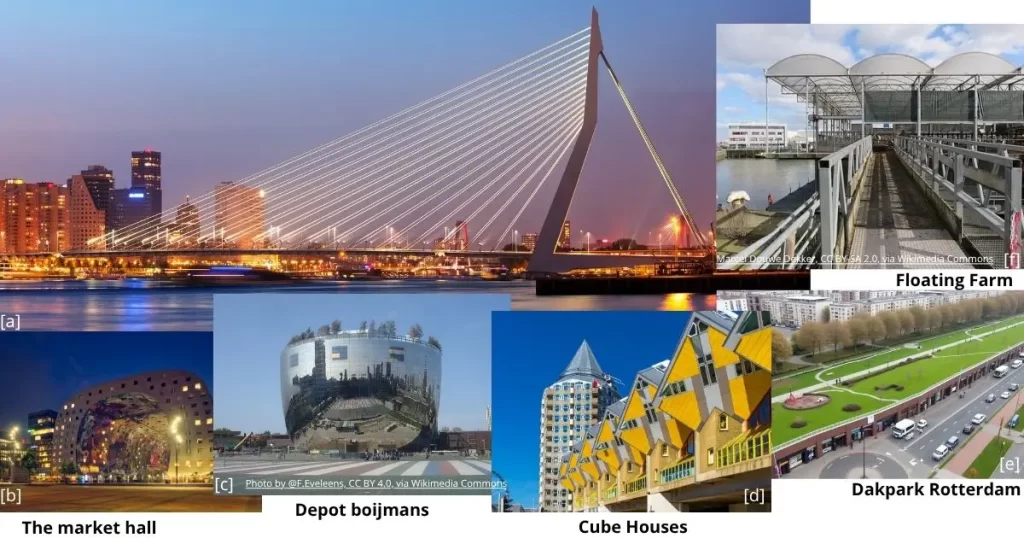
[c] Depot Boijmans: Photo by @F.Eveleens, CC BY 4.0, via Wikimedia Commons;
[f] : Floating farm : Photo by @Marcel Douwe Dekker, CC BY-SA 2.0, via Wikimedia Commons
Green Design Icons: The Markthal, Depot Boijmans & Cube Houses
Rotterdam is a global showcase of Green Design. The Markthal, with its energy-efficient systems and food-first philosophy, brings community and climate action under one roof. Nearby, the striking Depot Boijmans Van Beuningen is the world’s first publicly accessible art storage facility— and it features a lush green roof.
Then there are the Cube Houses, a bold experiment in modular and space-efficient urban living. These architectural icons prove that Sustainable Architecture doesn’t have to compromise on aesthetics or imagination.
Rotterdam’s Climate-Resilient Strategy: Smart Flood Management
As a low-lying city, Rotterdam faces daily reminders of climate risk. Instead of retreating, it innovates. The city’s Room for the River strategy transforms flood-prone areas into public parks that absorb water. Water Squares collect and filter rainwater, preventing urban flooding.
The Maeslantkering—Europe’s enormous storm surge barrier—guards Rotterdam’s harbor. But resilience goes beyond infrastructure. Education, citizen science, and inclusive planning are central to Rotterdam’s model. The city turns vulnerability into opportunity by treating climate resilience as a catalyst for innovation.
Visit Rotterdam for Innovation-Driven Green Living
Rotterdam invites you to experience sustainability as a way of life. Consider staying at eco-friendly hotels such as Room Mate Bruno, for example. A hotel that uses green tech and recycled materials. You can also participate in cycling tours of the city’s rooftop gardens or explore zero-waste boutiques in the Laurenskwartier area.
The city offers everything a conscious traveler could want: ethical dining, clean transport, and inspiring design. Whether you’re curious about urban innovation or passionate about climate action, Rotterdam proves that cities can be bold, beautiful, and deeply sustainable.
6. What to Look for When Exploring Green Cities in Europe
Green cities go far beyond their scenic views and smart designs. In this section, we’ll explore what indeed makes a city sustainable and how you, as a conscious traveler, can experience these places responsibly. From visible green spaces to invisible energy systems, here’s what to look out for.
Signs of True Sustainability: Transportation, Energy, Design & Community
When exploring a Green City, it’s essential to look beyond superficial attributes. Aesthetic parks and bike lanes are just part of the story. The accurate indicators of Sustainability lie in systems, not slogans. Look for cities that prioritize clean energy, low-carbon transport, eco-conscious design, and inclusive communities.
Key signs include:
- Efficient public transport: electric buses, metro lines, and bike-sharing systems
- Energy performance: cities powered by wind, solar, or district heating networks
- Green building codes: use of recycled materials, insulation, and passive design
- Public engagement: programs that involve locals in green initiatives
- Urban biodiversity: native plantings, wildlife corridors, and pollinator-friendly parks
These elements work together to create a livable and regenerative urban environment. They show that green living isn’t a feature—it’s a foundation.
How to be a Responsible Traveler in a Green City
Traveling sustainably doesn’t mean sacrificing comfort. It means making choices that align with the city’s eco-values. Start by utilizing public transportation or renting a bicycle. Select accommodations that are certified for their environmentally friendly practices. Support local artisans, farmers, and zero-waste shops.
Be mindful of your water and energy use. Carry a reusable water bottle and cloth bag. Visit green attractions that invest in conservation. Respect local customs and participate in eco-tours that educate and empower.
Most importantly, leave a positive impact. Share your experience to inspire others. Responsible travelers respect the place they visit and contribute to its resilience.
Planning Your Itinerary: Eco-Hotels, Local Green Tours, and Events
Planning a green itinerary can be exciting and rewarding. Start by selecting eco-certified hotels—many European cities offer accommodations with Green Key, EU Ecolabel, or LEED credentials. These places often utilize renewable energy, local food, and low-waste practices.
Join green walking tours to explore Sustainable Architecture, rooftop gardens, and community projects. In cities like Berlin, Copenhagen, or Rotterdam, there are often events like climate festivals, design expos, and farmers’ markets to attend.
Make room in your schedule for museums like Futurium (Berlin), CopenHill (Copenhagen), or the Floating Farm (Rotterdam). These places blend fun and education, helping you see sustainability in action.
By crafting your journey with care, you deepen your connection with the cities—and become part of the global green movement.
In conclusion,
Europe’s green cities are not only beautiful, but they also serve as influential models for a better urban future. From Oslo’s harmonious blend of culture and conservation to Copenhagen’s cycling utopia, Berlin’s green initiatives, and London’s ambitious smart-city plans, each city tells a unique story of progress and purpose. Rotterdam, with its innovative floating farms and daring designs, proves that innovation and ecology can coexist.
Throughout this article, we’ve explored the essential features that define the Best Green Cities in Europe to Visit—from Green Buildings and efficient transit to vibrant public spaces and community-led sustainability. These cities are more than travel destinations—they are living labs of what’s possible.
The question now is: what kind of traveler will you be? Will you observe, or will you engage, learn, and bring back new ideas? As climate challenges grow, the way we explore the world matters more than ever. Let your next trip be a green one—not just for pleasure, but for purpose.
By choosing to visit, support, and celebrate Europe’s greenest cities, you’re not just seeing the sights—you’re joining a movement. A movement toward communities that work with nature, not against it. Toward places where the future already feels like home.
Leave a Comment

